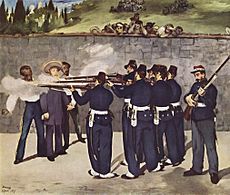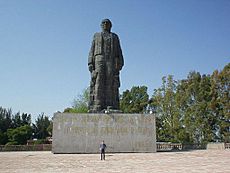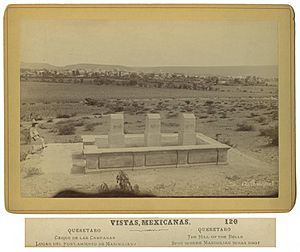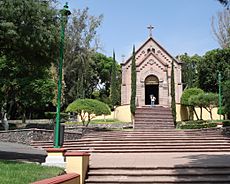Cerro de las Campanas facts for kids
The Cerro de las Campanas (which means "Hill of the Bells") is a famous hill and national park located in Querétaro City, Mexico. It's most well-known as the place where Emperor Maximilian I and his generals, Miguel Miramón and Tomás Mejía, were executed. This event marked the end of the Second Mexican Empire and the French influence in Mexico. The hill gets its name because some of its rocks make bell-like sounds when you hit them!
Contents
History of the Hill

This hill, once on the edge of Querétaro city, became famous as the place where the Second Mexican Empire ended. On May 15, 1867, Emperor Maximilian, who had been surrounded by republican forces in Querétaro since March, surrendered on this hill. He gave himself up to General Mariano Escobedo.
Maximilian was then held captive on the hill. His two generals, Miramón and Mejía, were also jailed with him. Miramón had even been a president of Mexico for a short time. Mejía was a brave cavalry general from Querétaro.
After a special trial in Querétaro, all three were sentenced to death. The sentence was carried out on top of the hill on June 19, 1867. Maximilian, Miramón, and Mejía were executed there.
At first, the spot was marked with piles of stones and crosses made from sticks. Later, wooden crosses were placed there. These wooden crosses are now kept safe in the Cerro de las Campanas Museum. In 1886, the first real monument was built. It had three stone columns with the names of the men who died. Iron bars surrounded them, held up by wooden posts. Governor Rafael Olvera ordered this monument to be built.
Emperor Maximilian Memorial Chapel
In 1900, Mexico and Austria became friends again. Because of this, the Emperor Maximilian Memorial Chapel was built on the hill. Emperor Franz Joseph I of Austria paid for it. He wanted to honor his brother, Maximilian. The chapel was officially opened on April 10, 1901.
Modern Uses and National Park

In the 1950s, a fairground was built on the western side of the hill. The Querétaro State Fair was held there for many years. However, the fair later moved to a new location in the early 1970s.
On May 15, 1967, exactly 100 years after Maximilian's capture, part of the hill was made a national park. This included the eastern side and the very top. On the same day, a statue of Benito Juárez was unveiled. Juárez was a very important president of Mexico. A new open area was also opened. President Gustavo Díaz Ordaz and Governor Manuel González Cosío y Rivera were there for the event.
The statue was designed by Juan F Olaguibel. At the bottom of the statue, there is a famous quote from Juárez. It says, Entre los individuos como entre las naciones, el respeto al derecho ajeno es la paz. This means, "Among people as among nations, respect for the rights of others is peace."
In the early 1970s, the southern and western parts of the hill, which used to be the fairgrounds, were given to the Autonomous University of Queretaro. The main campus of the university was opened there in December 1973.
Museum on the Hill
The local government of Querétaro runs a museum on the hill. It was built in 2003. The museum has five rooms with permanent exhibits. About 10,000 people visit the museum every month to learn about the hill's history.
See also
 In Spanish: Cerro de las Campanas para niños
In Spanish: Cerro de las Campanas para niños



